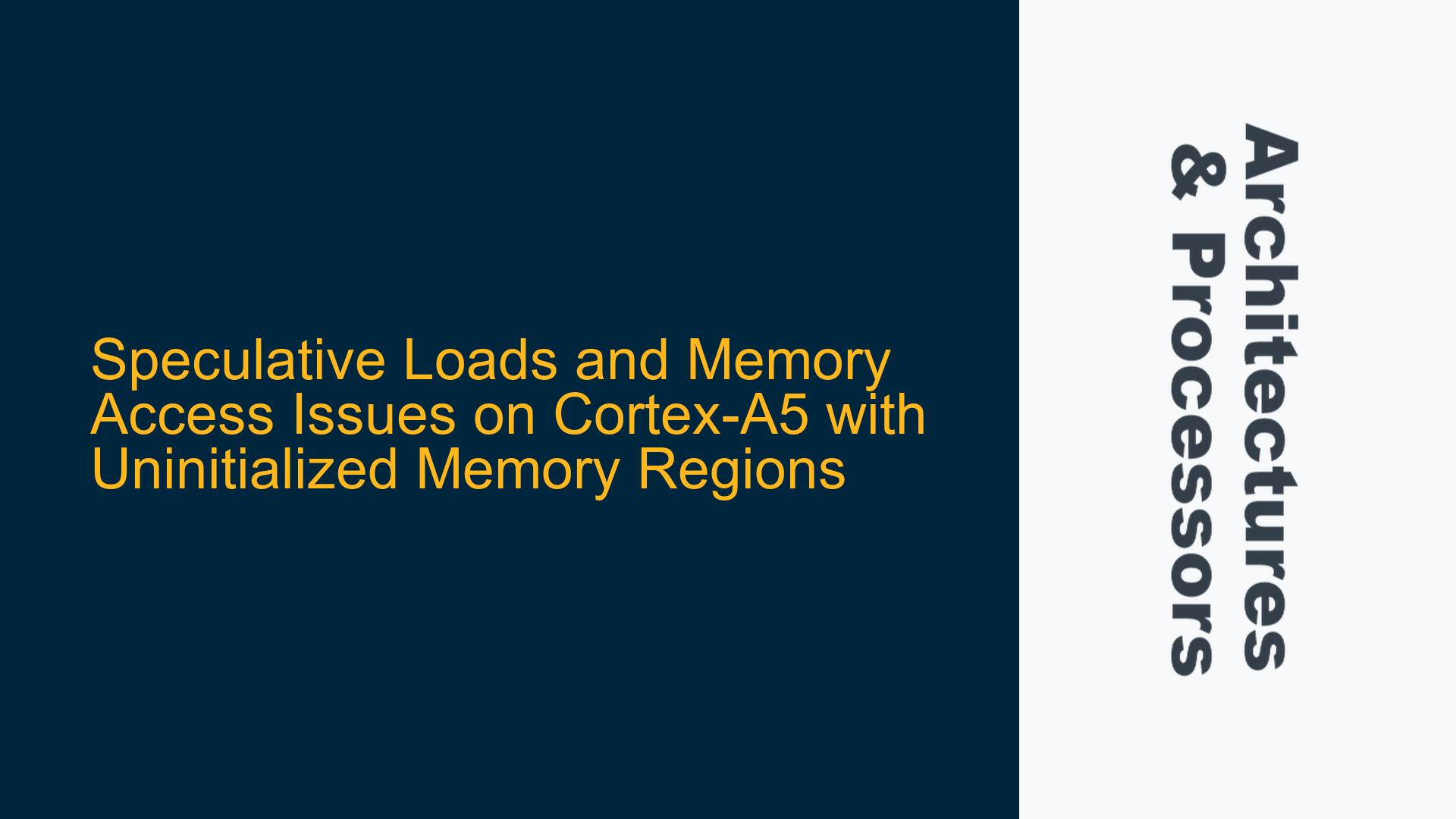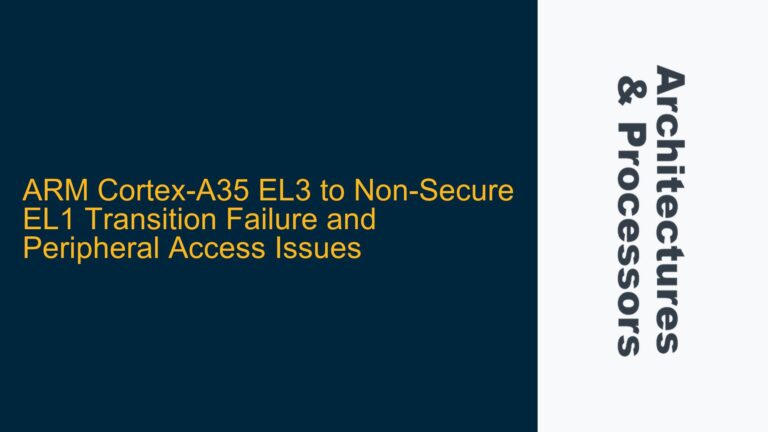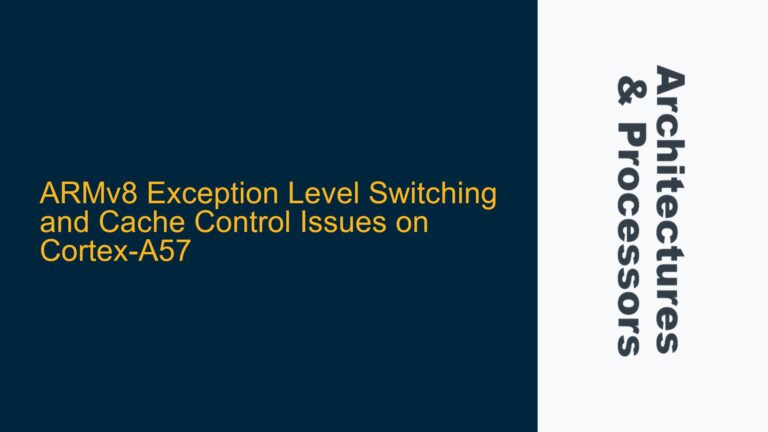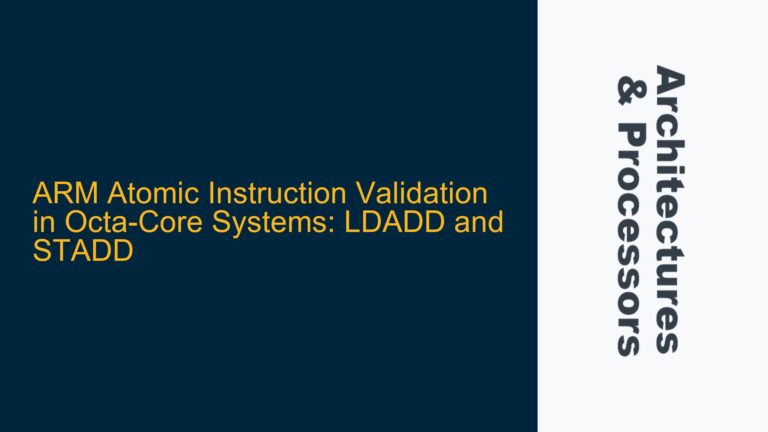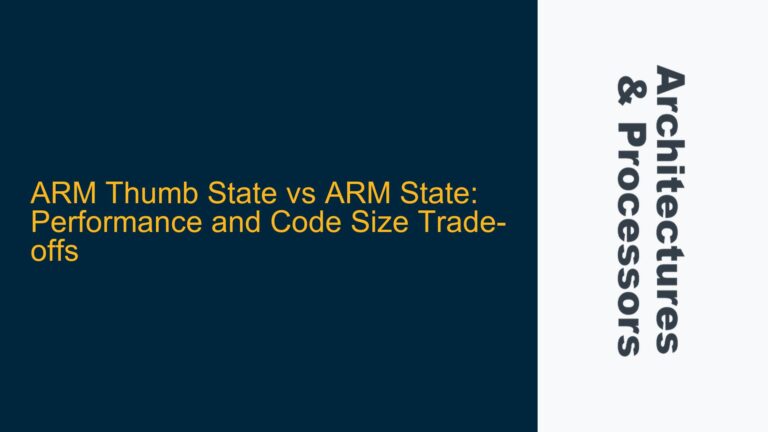Cortex-A5 Speculative Loads on Uninitialized Normal Memory Regions
The Cortex-A5 processor, despite being an in-order execution architecture, is capable of performing speculative loads and prefetching data from memory regions marked as Normal and cacheable. This behavior can lead to unintended memory access attempts, especially when the memory subsystem is not fully initialized or ready. In the described scenario, the Cortex-A5 maps a memory region R as Normal and cacheable before the region is physically accessible. During the execution of complex code, speculative loads or prefetching mechanisms attempt to access region R, causing hardware-level read accesses to uninitialized or unavailable memory. This results in observable issues such as bus faults, undefined behavior, or system instability.
The Cortex-A5’s memory subsystem is designed to optimize performance by prefetching data and speculatively loading cache lines. This is particularly true for Normal memory regions, which are expected to be cacheable and accessible without strict ordering constraints. However, when these regions are mapped before they are ready, the processor’s speculative behavior can trigger premature access attempts. This issue is exacerbated by the lack of explicit memory barriers or cache management instructions in the code, which would otherwise prevent such speculative accesses.
To understand the root cause, it is essential to analyze the Cortex-A5’s memory access behavior, the role of speculative loads, and the implications of mapping memory regions prematurely. The following sections delve into the possible causes and provide detailed troubleshooting steps to address this issue.
Speculative Prefetching and Cache Line-Fill Mechanisms in Cortex-A5
The Cortex-A5 processor employs several mechanisms to optimize memory access, including speculative prefetching and cache line-fill operations. These mechanisms are designed to reduce memory latency by anticipating future memory accesses and preloading data into the cache. However, they can also lead to unintended side effects when accessing uninitialized or unavailable memory regions.
Speculative prefetching in the Cortex-A5 is triggered by patterns in memory access, such as sequential or strided access to cacheable memory regions. The processor’s prefetch unit monitors load/store instructions and attempts to predict future memory addresses based on past access patterns. When a memory region is marked as Normal and cacheable, the prefetch unit assumes that the region is accessible and may initiate speculative loads to fill cache lines. This behavior is independent of whether the memory region is physically ready or not.
Cache line-fill operations are another critical aspect of the Cortex-A5’s memory subsystem. When a cache miss occurs, the processor initiates a line-fill operation to fetch the required data from memory. If the memory region is not ready, the line-fill operation can result in a bus fault or undefined behavior. In the described scenario, the speculative loads and cache line-fill operations are likely the cause of the observed hardware-level read accesses to region R.
Additionally, the Cortex-A5’s L1 and L2 cache subsystems play a significant role in this behavior. The L1 cache is tightly coupled with the processor core and handles speculative loads and prefetching. The L2 cache, if present, further amplifies this behavior by prefetching data from memory and storing it in anticipation of future accesses. The combination of these mechanisms can lead to premature access attempts to uninitialized memory regions.
To mitigate these issues, it is crucial to understand the timing and conditions under which speculative loads and prefetching occur. The following table summarizes the key mechanisms and their implications:
| Mechanism | Description | Implications for Uninitialized Memory |
|---|---|---|
| Speculative Prefetching | Predicts future memory accesses based on past patterns | May trigger premature access attempts |
| Cache Line-Fill | Fetches data from memory on cache misses | Can result in bus faults if memory is not ready |
| L1 Cache Behavior | Handles speculative loads and prefetching | Directly impacts core performance and stability |
| L2 Cache Behavior | Prefetches data from memory and stores it for future accesses | Amplifies speculative access attempts |
Implementing Memory Barriers and Cache Management to Prevent Speculative Access
To address the issue of speculative loads and premature memory access on the Cortex-A5, a combination of memory barriers and cache management techniques can be employed. These measures ensure that memory regions are accessed only when they are ready and prevent speculative behavior from causing unintended side effects.
Memory barriers, such as Data Synchronization Barriers (DSB) and Data Memory Barriers (DMB), can be used to enforce strict ordering of memory accesses. By inserting these barriers before and after critical sections of code, developers can prevent speculative loads from accessing uninitialized memory regions. For example, a DSB instruction ensures that all memory accesses before the barrier are completed before any subsequent accesses are initiated. This can be particularly useful when mapping memory regions or transitioning between different memory states.
Cache management instructions, such as cache invalidation and cleaning, are also essential for controlling speculative behavior. The Cortex-A5 provides instructions like Invalidate Data Cache (DCISW) and Clean Data Cache (DCCSW) to manage cache contents. By invalidating the cache for region R before it becomes accessible, developers can prevent speculative loads from fetching stale or invalid data. Similarly, cleaning the cache ensures that any modified data is written back to memory before the region is accessed.
Another effective approach is to delay the mapping of memory region R until it is fully initialized and ready. This can be achieved by modifying the memory management unit (MMU) configuration at runtime. By mapping region R as Device or Strongly-Ordered memory initially, developers can prevent speculative loads and prefetching. Once the region is ready, it can be remapped as Normal and cacheable memory. This approach ensures that speculative behavior does not interfere with the initialization process.
The following steps outline a comprehensive solution to prevent speculative access to uninitialized memory regions:
- Insert Memory Barriers: Use DSB and DMB instructions to enforce memory access ordering. Place these barriers before and after critical sections of code that involve memory mapping or access.
- Invalidate Cache: Use cache invalidation instructions (e.g., DCISW) to clear the cache for region R before it becomes accessible. This prevents speculative loads from fetching stale data.
- Clean Cache: Use cache cleaning instructions (e.g., DCCSW) to write back modified data to memory before accessing region R. This ensures data consistency and prevents corruption.
- Delay Memory Mapping: Map region R as Device or Strongly-Ordered memory initially to prevent speculative loads. Once the region is ready, remap it as Normal and cacheable memory.
- Monitor Prefetch Behavior: Use performance counters or debugging tools to monitor prefetch behavior and identify potential issues. Adjust prefetch settings if necessary to minimize speculative access attempts.
By implementing these measures, developers can effectively mitigate the risks associated with speculative loads and premature memory access on the Cortex-A5. These techniques not only address the immediate issue but also enhance the overall stability and reliability of the system.
In conclusion, the Cortex-A5’s speculative load and prefetching mechanisms, while beneficial for performance, can lead to unintended memory access attempts when dealing with uninitialized or unavailable memory regions. By understanding these mechanisms and employing appropriate memory barriers and cache management techniques, developers can ensure that memory regions are accessed only when they are ready, preventing system instability and undefined behavior.
